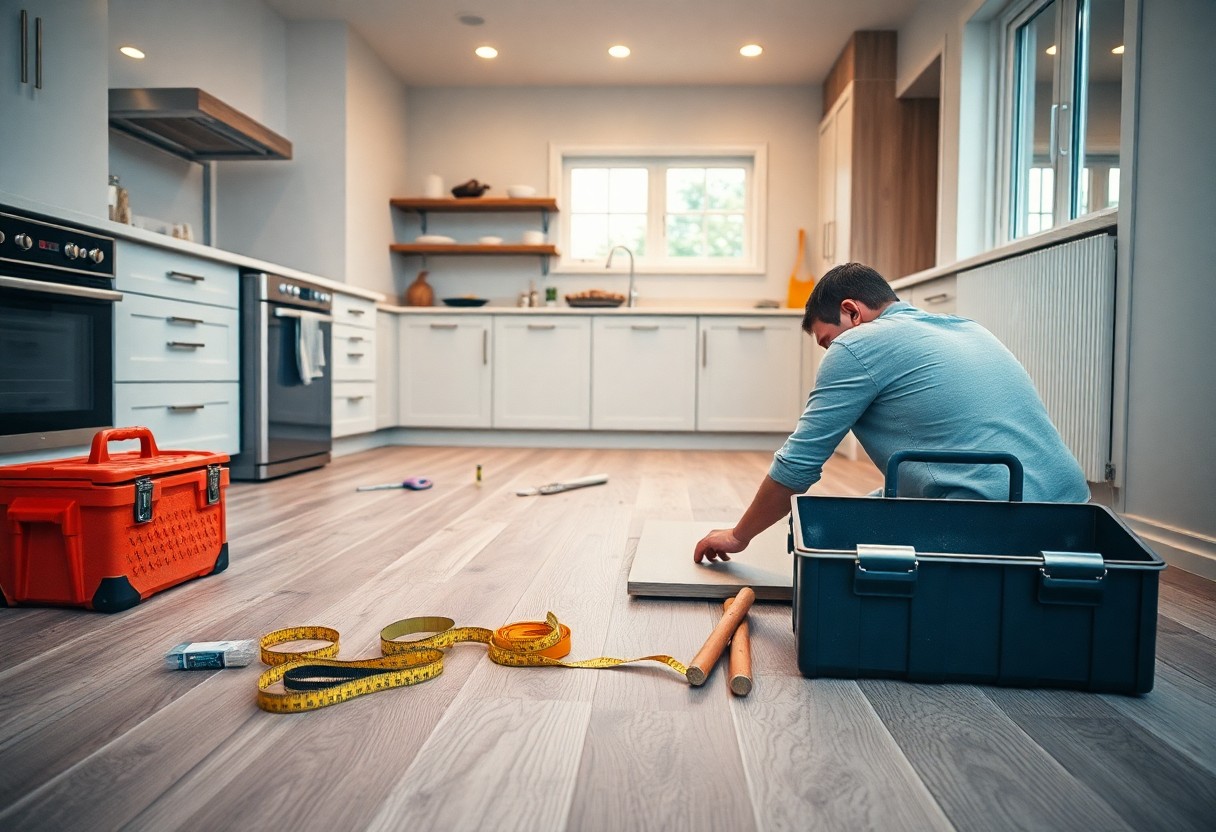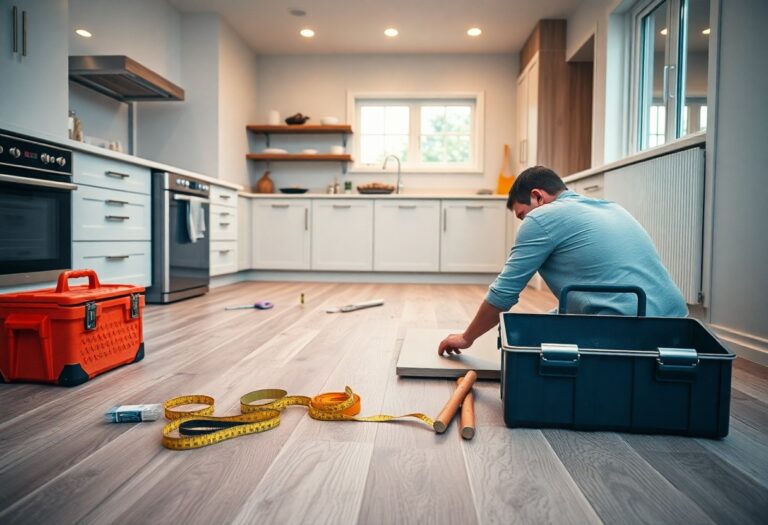Flooring installation can transform your space, and laminate is a popular choice for its durability and aesthetic appeal. In this guide, you’ll discover a step-by-step process tailored for homeowners in Kitchener, complete with practical tips to ensure your installation goes smoothly. From preparation to the final touches, you’ll gain the confidence and skills needed to successfully complete your project. Let’s investigate the crucials of laminate flooring installation and turn your vision into reality.
Choosing the Right Laminate Flooring
Choosing the right laminate flooring involves assessing various aspects that cater specifically to your home and lifestyle. Whether you have kids, pets, or simply prefer a low-maintenance option, understanding the types of laminate available will help you make an informed decision. Pay attention to the AC (Abrasion Class) rating, which indicates the durability and resistance to wear. Higher-rated laminates are best for high-traffic areas, while lower ratings can work well in more serene spaces.
Evaluating Your Needs and Lifestyle
Your needs and lifestyle will significantly influence your choice of laminate flooring. Consider factors such as foot traffic, the presence of children and pets, and even your cleaning habits. If your household is bustling with activity, opt for a high AC rating for maximum durability. For quieter spaces, you might choose a medium rating that offers comfort without compromising on aesthetics.
Picking the Perfect Style, Color, and Texture
Selecting the perfect style, color, and texture of laminate flooring is important to creating a cohesive look in your space. Take into account your existing décor and the mood you wish to achieve. Warmer tones can create an inviting atmosphere, while cooler shades may add a modern vibe. Additionally, textured laminates can enhance the natural look of wood, offering a tactile experience that can elevate your interior design.
Exploring different styles is part of the fun in choosing laminate flooring. Think about whether you want the classic look of oak or the contemporary appeal of a gray-hued laminate. Beyond color, the texture can play a significant role in your overall impression; hand-scraped or embossed finishes provide a more authentic appearance. You can mix and match colors and textures to create unique patterns or focal points. Seeing samples in different lighting conditions around your home will also help you envision how they will look day-to-day.

Essential Tools and Materials
Proper tools and materials play a pivotal role in executing a successful laminate flooring installation. Equipping yourself with the right resources not only makes the process smoother but also ensures a durable and polished finish. Before stepping into the project, ensure you have everything on hand to avoid unnecessary interruptions and delays.
Must-Have Installation Tools
Your success starts with a few imperative tools that will simplify the installation process. A saw, either a miter or circular saw, will help you make accurate cuts to the laminate planks. You’ll also need a tapping block and pull bar for perfecting seams, along with a measuring tape to ensure precise dimensions. Don’t forget a square for checking corners, a vacuum to keep the area tidy, and a rubber mallet for shifting planks into place.
Selecting Quality Underlayment and Accessories
The underlayment serves as a vital foundation for your laminate flooring, impacting both comfort and stability. A moisture barrier underlayment is ideal for areas prone to spills or humidity, while sound-absorbing options can enhance the acoustic quality of your space. Accessories like transition strips and profile moldings should match your aesthetic and integrate seamlessly with your flooring design.
Choosing high-quality underlayment can significantly enhance your laminate flooring’s performance and longevity. For instance, products with a higher density often offer better moisture protection and thermal insulation, leading to increased comfort underfoot. Additionally, consider selecting underlayment with added features such as noise reduction properties to minimize sound transmission. Investing time in researching and selecting the right underlayment and accessories will pay off by prolonging the life of your laminate flooring and improving your overall satisfaction with the finished product.
Preparing Your Space
Before you begin laying down your new laminate flooring, preparing your space is important to ensure a smooth installation process. This involves making your area clean and organized, as well as addressing any potential issues with your subfloor. Taking these steps will help in achieving a high-quality finish and prolonging the life of your new flooring.
Clearing and Cleaning the Area
The first step is to remove all furniture, appliances, and any other items from the area where you’ll be working. After clearing the space, thoroughly clean the floor to eliminate dust, dirt, and debris that could interfere with the installation. A vacuum followed by a damp mop will help in ensuring your workspace is spotless.
Addressing Subfloor Issues
Before installation, inspect your subfloor for any issues that could affect the laminate’s longevity and performance. Look for signs of sagging, water damage, or unevenness. Make necessary repairs such as reinforcing weak spots or leveling uneven areas with a concrete patch or underlayment material. A level and stable subfloor is crucial for achieving a durable and visually appealing outcome with your laminate flooring.
Addressing subfloor issues might involve using a leveling compound to fill dips and low spots. This is particularly important in older homes, where settling can create uneven surfaces. Measure the subfloor’s height in multiple spots to determine the extent of the leveling needed. If your subflooring consists of wooden planks, ensure they are sturdy, free from rot, and adequately supported. Proper preparation of your subfloor will prevent future problems, such as warping or squeaking, thereby enhancing the durability of your laminate flooring.
Step-by-Step Installation Process
| Step | Description |
|---|---|
| 1. Prepare the Room | Clear the area, removing all furniture and baseboards. |
| 2. Laying the Underlayment | Install the underlayment to provide cushioning and sound absorption. |
| 3. Plank Placement | Begin laying the planks from one corner, staggering the seams. |
| 4. Tricks for Cutting | Use a proper cutting tool for clean edges and fits. |
| 5. Finishing Touches | Reattach baseboards and add transition strips as needed. |
Laying the Underlayment
The underlayment is a vital foundation for your laminate flooring. Begin by rolling out the underlayment across the entire floor area, ensuring it covers all spaces. Overlap seams by a few inches and trim excess material with a utility knife. This layer acts as a moisture barrier and sound deadener, contributing to the overall comfort of your flooring.
Plank Placement Techniques
Start placing your planks from one corner of the room. To create an aesthetic look, stagger the seams by cutting some planks in half for the next row. This method not only improves visual appeal but also enhances the stability of the flooring. Utilize spacers along the walls to allow for expansion, ensuring the planks don’t buckle over time.
Lay the first plank and connect it to the next by angling it slightly and pressing it down until you hear a click. For larger areas, continuing in this manner creates a ripple effect of installation, allowing you to work more efficiently. Check the alignment regularly, as minor adjustments will keep the flooring looking its best throughout its lifespan.
Tricks for Cutting and Fitting Planks
Cutting laminate planks requires precision. Use a table saw for straight cuts, and a jigsaw is ideal for curved cuts or holes for vents. Always measure twice before cutting to minimize waste. If a plank is slightly too long, use a block plane to shave off small amounts for a perfect fit.
When cutting, flip the plank upside down to avoid chipping the surface layer. For maximum accuracy in fitting planks into tight corners, utilize a scribing tool to trace the edge of the wall. This approach ensures your planks fit snugly against irregular wall lines, enhancing the final look of your flooring installation.
Post-Installation: Maintenance and Care
Once your laminate flooring is installed, proper maintenance and care are necessary to maximize its durability and appearance. Regularly attending to your floors will not only keep them looking new but also prolong their lifespan. Developing a routine for cleaning and safeguarding your laminate will ultimately lead to fewer repairs and replacements in the future.
Cleaning Tips for Longevity
To keep your laminate flooring in top condition, implement simple cleaning techniques:
- Use a microfiber mop or cloth for regular dusting.
- Clean spills promptly to prevent moisture damage.
- Use a gentle laminate floor cleaner for deeper cleans.
- Avoid steam mops, as excessive water can damage the planks.
- Place doormats at entryways to reduce dirt tracking inside.
Thou will find that these basic steps significantly enhance the longevity of your flooring.
Preventative Measures for Damage
Taking proactive steps to prevent damage can save costs and headaches in the long run. Consider placing felt pads under furniture legs and avoiding sharp objects that could scratch the surface. Additionally, using area rugs in high-traffic zones will help to minimize wear and tear. Be attentive to the humidity levels in your home—excessive moisture or dryness can warp or separate laminate planks. Ensuring the space is well-ventilated and maintaining a balanced humidity level between 35% to 65% will minimize risks. Regularly assess for signs of wear and address any concerns before they lead to larger problems.
Summing up
With this in mind, your laminate flooring installation in Kitchener can be a rewarding process when you follow a well-structured approach. By preparing your space, understanding the tools needed, and adhering to the step-by-step guidelines, you’ll ensure a professional-looking finish. Take the time to measure accurately and maintain proper acclimation for your materials, as these details contribute to the overall success of your project. With patience and focus, you can transform your space with beautiful laminate flooring that enhances your home’s aesthetic and functionality.





